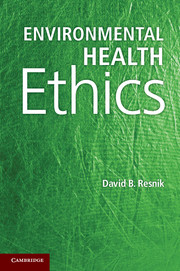Book contents
- Frontmatter
- Contents
- Figures and Tables
- Acknowledgments
- Abbreviations
- 1 Introduction
- 2 An Overview of Environmental Health
- 3 Ethical Theory
- 4 Toward an Environmental Health Ethics
- 5 Pest Control
- 6 Genetic Engineering, Food, and Nutrition
- 7 Pollution and Waste
- 8 The Built Environment
- 9 Climate Change, Energy, and Population
- 10 Justice and Environmental Health
- 11 Environmental health Research Involving Human Participants
- 12 Conclusion
- References
- Index
12 - Conclusion
Published online by Cambridge University Press: 05 July 2012
- Frontmatter
- Contents
- Figures and Tables
- Acknowledgments
- Abbreviations
- 1 Introduction
- 2 An Overview of Environmental Health
- 3 Ethical Theory
- 4 Toward an Environmental Health Ethics
- 5 Pest Control
- 6 Genetic Engineering, Food, and Nutrition
- 7 Pollution and Waste
- 8 The Built Environment
- 9 Climate Change, Energy, and Population
- 10 Justice and Environmental Health
- 11 Environmental health Research Involving Human Participants
- 12 Conclusion
- References
- Index
Summary
Environmental health research and scholarship have come a long way since Rachel Carson published Silent Spring more than four decades ago, but the ethical and policy issues raised in her book still have relevance today. Questions about the appropriate use of pesticides reflect the ongoing tension between protecting the environment and promoting human interests. But, as we have seen in this book, environmental health controversies go beyond the one-dimensional humanity versus environment theme, and are shaped by a rich array of values and interests, such as public health, individual autonomy, property rights, justice, utility, economic development, animal welfare, biodiversity preservation, and ecological sustainability. Although people often equate protecting the environment with promoting human health, these two values are sometimes at odds, as illustrated by debates about whether to spray DDT indoors to control malaria, build dams to provide water for communities, or grow GM crops to feed a growing population.
The scope of this book has ranged from local concerns, such as toxic waste site placement, housing standards, urban development, water resource use, and occupational safety, to national and global concerns, such as climate change, energy use, pollution, population control, and agriculture. The book has examined perennial topics, such as air and water quality, pesticide use, and solid waste disposal, as well as new and emerging ones, such as GM crops, nanotechnology, geoengineering, environmental justice, and protection of human subjects in environmental health research. The book has described some of the laws, regulations, and treaties relevant to environmental health, as well as moral concepts, theories, and principles.
- Type
- Chapter
- Information
- Environmental Health Ethics , pp. 242 - 248Publisher: Cambridge University PressPrint publication year: 2012

